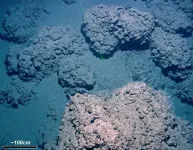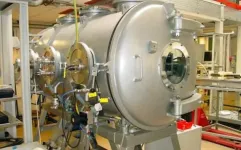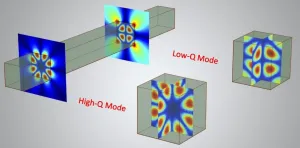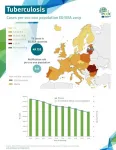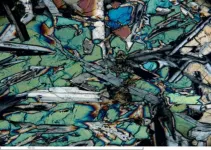A sense for the unseen: Novel DNA sensor can rapidly detect antibiotic-resistant pathogens
Researchers develop novel culture-free self-driven DNA nanosensor that can rapidly and accurately detect antibiotic resistant pathogens
2021-03-22
(Press-News.org) Antibiotics have revolutionized the field of medicine by making it possible to treat most known microbial diseases today. However, their uncontrolled usage has led to the major global problem of antibiotic resistance. As we continue to exploit antibiotics, sometimes at doses much higher than needed, disease-causing bacteria are rapidly evolving defense strategies to evade them. These drug-resistant bacteria, also known as "superbugs," cause severe infections that are difficult to treat and can eventually be fatal.
Methicillin-resistant Staphylococcus aureus (MRSA), a particularly vicious group of superbugs that have developed resistance to the antibiotic methicillin, is a major cause of hospital-acquired infections. Accurate and timely diagnosis is crucial for effective treatment. However, antibiotic sensitivity tests, the gold standard used to assess bacterial response to various drugs, are incredibly lengthy processes and can take up to a few days to yield results. Although alternative techniques employing enzymes and biosensors have shown some promise, they are dependent on external driving forces (like electrical or magnetic energy) raising the element of uncertainty.
In their search for a simpler and more reliable detection tool, researchers from Taiwan and Japan have now developed a highly sensitive culture-free and self-driving DNA nanosensor that can accurately detect lethal superbugs like MRSA. The nanosensor is primarily based on Brownian motion, a term used to refer to the self-driven random and erratic movement of microparticles. Excited about their findings published in Biosensors and Bioelectronics, Dr. Hiroaki Sakamoto, an Associate Professor at University of Fukui, Japan, and co-author of the study, says, "We have designed a novel Brownian motion-enabled DNA nanosensor that can specifically detect MRSA DNA with high sensitivity, enabling rapid and precise sensing of a microorganism's DNA by diffusometry without sophisticated DNA amplification or cell culture."
The preparation of these sensors took place in three steps. First, the researchers prepared short sequences of DNA, called oligonucleotide probes, that could recognize two different target sequences in the DNA of MRSA. To one of these probes, they attached fluorescent beads to be used for accurate visual quantification of particle movement. To the other, they attached bulky gold nanoparticles, which decrease the diffusivity or the rate of movement of the nanobead. When mixed together with MRSA DNA, the researchers saw that both the probes "sandwiched" the DNA, making their detection easy and rapid. The researchers also confirmed the specificity of the sensor from its inability to bind other DNA from other bacteria such as Escherichia coli.
The team's novel biosensor design not only eliminates the need for time-consuming and laborious cell culture, but also simplifies sensor configuration without the requirement of any complex fabrication, resources, and external energy sources. Moreover, the nanosensor significantly decreases the detection time to a mere 10 seconds! Besides, it has a low limit of detection and can detect minute concentrations of up to 10 pM, thus facilitating quick and accurate diagnosis of infectious pathogens from extremely limited samples. It can also be customized for the detection of other pathogens apart from MRSA by modifying the target DNA binding sequence.
Regarding the important long-term applications of their work, Prof. Sakamoto explains, "In order to coexist with the threat of infectious pathogens, rapid and simple testing detection technology that can enable timely diagnosis and treatment is essential. Even if a new pathogen emerges, the social disruption that may occur due to the outbreak can be minimized as much as possible in future using DNA detection sensors."
Indeed, their novel DNA nanosensor is a cost-effective and rapid detection device that can strengthen our combat in the war against antibiotic resistance.
INFORMATION:
Reference
Title of original paper: Culture-free detection of methicillin-resistant Staphylococcus aureus by using self-driving diffusometric DNA nanosensors
Journal: Biosensors and Bioelectronics
DOI: 10.1016/j.bios.2019.111817
About University of Fukui, Japan
The University of Fukui is a preeminent research institution with robust undergraduate and graduate schools focusing on education, medical and science, engineering, and global and community studies. The university conducts cutting-edge research and strives to nurture human resources capable of contributing to society on the local, national, and global level.
Website: https://www.u-fukui.ac.jp/eng/
About Dr. Hiroaki Sakamoto and Dr. Shin-ichiro Suye from University of Fukui, Japan
Dr. Hiroaki Sakamoto is an Associate Professor at the Department of Frontier Fiber Technology and Science, Graduate School of Engineering, University of Fukui, Japan. He completed his doctoral and post-doctoral studies in engineering and nano-sciences. His research interests include studying nanoparticles, nanofibers, and biosensors and their potential industrial and medical applications. He has authored several peer-reviewed articles in these domains.
Dr. Shin-ichiro Suye is the Executive Vice President for Research at University of Fukui, Japan. He completed his master's degree in agriculture chemistry at Tokyo University of Agriculture and Technology, and then obtained his Ph.D. in enzyme technology from Kyoto University. His post-doctoral studies were focused on the development of biosensing systems with bionanotechnology. His main research interests are the development of biofuel cells by combining research from fields such as enzyme technology, genetic engineering, and bionanotechnology.
About Professor Han-Sheng Chuang from National Cheng Kung University, Taiwan
Dr. Han-Sheng Chuang is a Full Professor at the Department of Biomedical Engineering, National Cheng Kung University, Taiwan. Dr. Chuang received his Ph.D. from the School of Mechanical Engineering at Purdue University, USA. His research interests include biomicrofluidics, bio-MEMS/NEMS, optical diagnostics, and Caenorhabditis elegans. Dr. Chuang is currently the Guest Editor for a special issue in the journal Biosensors and an Associate Editor for Frontiers in Bioengineering and Biotechnology. Since 2020, he has also served as the President of the Association of Chemical Sensors in Taiwan (ACST). ACST is a professional non-profit organization focusing on sensing technologies with more than 200 academic and industrial members.
Funding information
This study was supported by the Ministry of Science and Technology, Taiwan under the grants 107-2221-E-006-054-MY3 and 108-2622-E-006-007-CC2. In addition, Jhih-Cheng Wang and Tai-Hua Yang would also like to thank Chi Mei Medical Center for the collaborative grant CMNCKU10805.
ELSE PRESS RELEASES FROM THIS DATE:
2021-03-22
Boulder, Colo., USA: Beneath the cold, dark depths of the Arctic ocean sit vast reserves of methane. These stores rest in a delicate balance, stable as a solid called methane hydrates, at very specific pressures and temperatures. If that balance gets tipped, the methane can get released into the water above and eventually make its way to the atmosphere. In its gaseous form, methane is one of the most potent greenhouse gases, warming the Earth about 30 times more efficiently than carbon dioxide. Understanding possible sources of atmospheric methane is critical for accurately predicting future climate change.
In the Arctic Ocean today, ice sheets exert pressure on the ground below them. That pressure diffuses ...
2021-03-22
Screenings for breast cancer and colon cancer dropped dramatically during the early months of the coronavirus pandemic, but use of the procedures returned to near-normal levels by the end of July 2020, according to a new study.
Analyzing insurance claims from more than 6 million Americans with private health coverage, researchers found that mammography rates among women aged 45 to 64 declined by 96% during March and April 2020 as compared to January and February.
Similarly, the weekly rate of colorectal cancer screenings among adults aged 45 to 64 and older declined by 95% during the period.
By the end of July 2020, however, the rate of mammograms among women had rebounded and was slightly higher than it had been before the pandemic was declared. The rate of colonoscopies also rebounded, ...
2021-03-22
Researchers at Trinity College Dublin have been shedding light on the enigmatic "spiders from Mars", providing the first physical evidence that these unique features on the planet's surface can be formed by the sublimation of CO2 ice.
Spiders, more formally referred to as araneiforms, are strange-looking negative topography radial systems of dendritic troughs; patterns that resemble branches of a tree or fork lightning. These features, which are not found on Earth, are believed to be carved into the Martian surface by dry ice changing directly from solid to gas (sublimating) in the spring. Unlike Earth, Mars' atmosphere comprises mainly of CO2 and as temperatures decrease in winter, this deposits onto the surface as CO2 ...
2021-03-22
Optical resonators provide the foundation of modern photonics and optics. Thanks to its extreme energy confinement, the high-Q-factor optical resonator optimizes light-matter interaction and photonic device performance by enabling low-threshold laser and enhanced nonlinear harmonic generation.
Two typical structures, the photonic crystal cavity and the whispering gallery cavity, are frequently used to obtain extremely high-Q factors. However, these structures may require dimensions that are comparable to--or several times larger than--the operating wavelength. Whether there is a general way to find out all high-Q modes in a dielectric ...
2021-03-22
The tuberculosis (TB) burden in the WHO European Region as a whole is decreasing, and is down 19% overall for 2015-2019, according to the latest WHO/European Centre for Disease Prevention and Control (ECDC) report Tuberculosis surveillance and monitoring in Europe 2021 (2019 data).
Regional TB mortality has gone down, declining by 9.4% between 2018 and 2019. This is notably higher than the average global decline in TB mortality (3.7%) and enough to have reached the End TB Strategy milestone of a 35% reduction by 2020 compared to 2015.
However, TB is second only to COVID-19 as an infectious disease that kills, and drug resistance is a major concern. There are also worrying indications that the COVID-19 pandemic may stall progress or cause significant setbacks in the fight against TB.
The ...
2021-03-22
Developing a standardized drying protocol for goldenseal could lead to more predictable health applications and outcomes by preserving the alkaloids found in the plant, which is native to Appalachia, according to Penn State researchers, who conducted a new study of the medicinal forest herb.
The roots and rhizomes of goldenseal -- Hydrastis canadensis -- have been used for hundreds of years as a source of antimicrobials and compounds to treat intestinal ailments, noted study co-author Eric Burkhart, associate teaching professor, ecosystem science ...
2021-03-22
Antibody injections are a highly desirable treatment for people with chronic diseases such as cancer, psoriasis, Crohn's disease and arthritis. And recently, antibodies have been in the news as a promising treatment for severe cases of COVID-19.
But the costly, time-consuming manufacturing process to produce antibodies prevents these treatments from being accessible to most patients.
Andrew Zydney, Bayard D. Kunkle Chair and professor of chemical engineering at Penn State, has identified a new method to manufacture antibodies, which could drive down the production cost. His research results were recently published in Biotechnology Progress.
"If you look at the top 10 best-selling medications, by annual sales, eight ...
2021-03-22
A new type of rock created during large and exceptionally hot volcanic eruptions has been discovered beneath the Pacific Ocean.
An international team of researchers including the University of Leeds unearthed the previously unknown form of basalt after drilling through the Pacific ocean floor.
The discovery suggests that ocean floor eruptions sourced in the Earth's mantle were even hotter and more voluminous than previously thought. Report co-author is Dr Ivan Savov, of Leeds' Institute of Geophysics and Tectonics, in the university's School of Earth and Environment.
He said: "In an era when we rightly admire discoveries made through space exploration, our findings show there are still many discoveries still to make on our ...
2021-03-22
The increasing frequency and severity of extreme weather events like droughts and floods have taken a toll on the midwestern U.S. in recent years, putting a major strain on the region's farmers. From 2001 to 2010, the Federal Crop Insurance Program, a government program created to protect farmers from crop loss, covered $4.1 billion in damages; in 2011 alone, the program paid out $10.8 billion.
With the largest U.S. crop -- corn -- conservatively estimated to drop in yield anywhere from 20 to 80 percent due to extreme weather exacerbated by climate change, insurance claims may skyrocket to levels that may not be sustainable. But researchers from the Yale School of the Environment (YSE) found that by considering soil properties when determining insurance premiums ...
2021-03-22
Less than a decade after unveiling the "Map of Life," a global database that marks the distribution of known species across the planet, Yale researchers have launched an even more ambitious and perhaps important project -- creating a map of where life has yet to be discovered.
For Walter Jetz, a professor of ecology and evolutionary biology at Yale who spearheaded the Map of Life project, the new effort is a moral imperative that can help support biodiversity discovery and preservation around the world.
"At the current pace of global environmental change, there is no doubt that many species will go extinct before we have ever learned ...
LAST 30 PRESS RELEASES:
[Press-News.org] A sense for the unseen: Novel DNA sensor can rapidly detect antibiotic-resistant pathogens
Researchers develop novel culture-free self-driven DNA nanosensor that can rapidly and accurately detect antibiotic resistant pathogens
